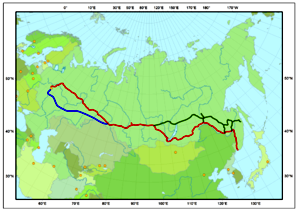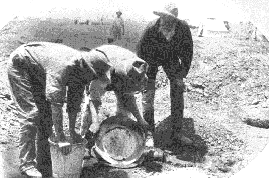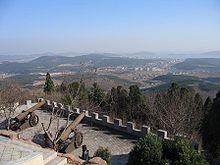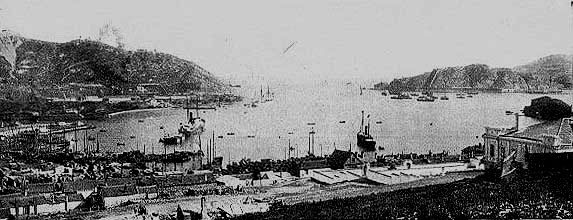
- •Сontents
- •Введение
- •Introduction
- •Unit I. Introductory part
- •1. Fill in the table:
- •2. Study the key vocabulary:
- •3. Scan the text. Political Situation in Russia in the 17th Century and Prerequisites for the Exploration of the Far East
- •4. Answer the following questions:
- •5. Complete the sentences:
- ••Moscow was occupied by ___________________________ .
- •Unit II. Movement to the far east Lesson 1. Expeditions of Ivan Moskvitin and Vasily Poyarkov
- •2. Study the key vocabulary:
- •3. Make up sentences with the key vocabulary.
- •4. Complete the sentences with the correct key vocabulary item:
- •5. Translate into English:
- •7. Scan the table. Analyze the peculiarities of the expeditions. What differences and similar features have you found?
- •9. Explain the meaning of the following expressions from the text.
- •Lesson 2. Yerofey Pavlovich Khabarov: a Successful Commercial Man and “Getter” of Russia
- •1. History test. Choose the correct variant to complete the sentences:
- •2. Read the text and explain the meaning of the word “khabar”. What does the word “khabar” mean?
- •3. Study the key vocabulary:
- •4. Match the following word-combinations with their definitions:
- •5. Make up sentences with the key phrases.
- •6. Scan the table. The Most Important Periods of y. P. Khabarov’s Biography
- •11. Find out about his Amur trip. What other trips did he undertake?
- •12. Explain why his way was shorter and better. Use maps.
- •13. Translate into Russian. Which natural riches of the Far East was Khabarov impressed by?
- •14. On your own. Use the Internet and other resources to find information about the character of y.P.Khabarov. Prove that he was a successful Russian commercial man.
- •15. Read the text and analyze all achievements of y. P. Khabarov. Explain why historians name him the “getter” of Russia.
- •Importance of Khabarov’s discoveries
- •16. Say what impressed you most in Khabarov’s fate.
- •17. Imagine you are a guide-interpreter. Make a presentation about the monument to y. Khabarov. Use the information from the text.
- •Vocabulary:
- •18. Write an essay on the following theme: “The city of Khabarovsk was named so because …”.
- •1. Study the key vocabulary:
- •2. Replace the following words and word-combinations by the synonyms:
- •3. Make up the sentences with the key vocabulary.
- •4. Scan the text and translate into Russian the sentences with the key vocabulary. Semеn Ivanovich Dezhnev
- •5. Answer the following questions:
- •6. Complete the sentences:
- •7. True or false? Write “t” if true, “f”, if false:
- •Part II
- •Vladimir Vasilyevich Atlasov
- •5. Prove that:
- •6. Answer the following questions:
- •7. Fill in the table:
- •8. Look at the map. Speak how the territory of Russia changed in the 17th century due to expeditions of famous Russian explorers.
- •9. Make a presentation about one of five famous explorers of the Far East.
- •1. Study the key-vocabulary:
- •2. Replace the following words and word-combinations by the synonyms:
- •3. Fill in the correct key word or word-combination:
- •3. Make up the sentences with the key vocabulary.
- •4. Scan the text and translate into Russian the sentences with the key vocabulary. Albazin Fortress
- •Lesson 5. Fatal Consequences of the Nerchinsk Treaty
- •Нерчинский трактат
- •9. Replace the following words and word-combinations by the antonyms:
- •10. Complete the following sentences with the correct key word or word-combination:
- •11. Make up the sentences with the key vocabulary.
- •12. Scan the text. Political Situation in the Far East
- •13. Look at the picture by a Chinese artist: “a battle for Albazin between Russian Cossacks and Daurs”. Explain what you see there.
- •14. Answer the following sentences:
- •Unit IV. Peter’s age in the far east
- •Alexey Mikhailovich and Nataliya Naryshkina
- •Alexey Mikhailovich and Maria Miloslavskaya
- •Lesson 6. Development of the Far Eastern Lands by Peter I
- •1. Study the key vocabulary:
- •2. Complete the following sentences with the correct key word or word-combination:
- •3. Translate into English:
- •4. Make up the sentences with the key vocabulary.
- •5. Scan the text. Achievements of Peter I in the Far East
- •6. Answer the following questions:
- •Lesson 7. Okhotsk: the Major Russian Port in the Pacific
- •6. Scan the text. Okhotsk Foundation
- •Lesson 8. Expeditions of Vitus Bering
- •4. Translate into English:
- •5. Scan the text.
- •Vitus Bering
- •6. Answer the following questions:
- •7. Complete the following sentences:
- •9. Translate into Russian:
- •10. Find on map №12 the places:
- •12. Give a summary of V. Bering’s life. Lesson 9. The First Steps to Explore the American Coast
- •1. Study the key vocabulary:
- •2. Explain the meaning of the following key vocabulary:
- •3. Match the words and word-combinations with their definitions:
- •4. Make up sentences with the key vocabulary.
- •5. Translate the sentences into Russian:
- •6. Scan the text. Problems with the Locals during the First Steps to Explore the American Coast
- •6. Answer the following questions:
- •Unit V. Russian america Lesson 10. Political Situation in the Pacific at the End of the 18th Century
- •Influenced the appearance of the new indigenous peoples in America.
- •2. Study the key vocabulary:
- •3. Match the following columns:
- •4. Translate into English:
- •5. Make up sentences with the key vocabulary.
- •6. Scan the text. Russian and American Frontiers
- •7. Answer the following questions:
- •8. Find in the text the sentences with the key vocabulary and translate them into Russian.
- •9. Complete the sentences:
- •Lesson 11. Functions of Russian Trade Stations on the American Shores
- •2. Replace the following words and word-combinations by the synonyms:
- •3. Match the following columns:
- •4. Find the words from the key vocabulary to match the following definitions:
- •5. Make up sentences with the key vocabulary.
- •6. Scan the text. Grigory Ivanovich Shelikhov – the Founder of Russian Business in NorthAmerica
- •7. Answer the following questions:
- •8. Write if the statement is true (t) or false (f):
- •Lesson 12.The Work of the Russian-American Company (rac)
- •Основание Российско-Американской компании
- •Vocabulary:
- •7. Make up the sentences with the key vocabulary.
- •8. Scan the text. The First Russian Joint-stock Commercial Enterprise in America
- •9. Answer the following questions:
- •16. Give a summary of the text.
- •17. A) Scan the table of persons who were the Governors of the Russian American Company. B) Find on map №16 places named by them. Governors of the Russian American Company
- •Lesson 13. Reforms of Nikolay Petrovich Rezanov in Russian America
- •1. Study the key vocabulary
- •9. Answer the following questions:
- •10. Write if the statement is true (t) or false (f):
- •Lesson 14. Decline of the rac and Sale of Russian Estates in America
- •2. Replace the following words by the antonyms:
- •6. Scan the text. Why Were the Colonial Possessions of Russian America Sold?
- •7. Answer the following questions:
- •8. Prove that the territory of Russian America was practically uninhabited.
- •11. Complete the sentences:
- •Исторические факты
- •Vocabulary:
- •Популярные мифы и заблуждения о продаже Аляски
- •1.Утверждается, что в связи с известными нарушениями договора, сделка может быть оспорена и по сей день.
- •3.В российской публицистике распространяется еще один миф, который гласит, что Аляска на самом деле была не продана, а сдана в аренду на 99 лет, но ссср по каким-то причинам не потребовал её обратно.
- •Vocabulary:
- •16. Read the newspaper article. Share your point of view about the perspectives of Russian-American business relations. From Russia with Love: Tunnel to Link Siberia and Alaska
- •Vocabulary:
- •1. What do you know about the settlement of the Amur area in the 19th century? Choose a correct answer to complete a sentence.
- •2. Study the key vocabulary:
- •3. Replace the following words with the synonyms:
- •7. Scan the text. Return of Russia to the Amur
- •7. Answer the following questions:
- •8. Complete the sentence:
- •Lesson 16. Important Discoveries of Captain Gennady Ivanovich Nevelskoy
- •3. Complete the sentences with the word or word-combinations from the key vocabulary :
- •4. Make up sentences with the key vocabulary.
- •5. Scan the text. The Life and Activities of the “Amur Admiral” Gennady Ivanovich Nevelskoy
- •6. Answer the following questions:
- •7. Translate into Russian the sentences with the key vocabulary.
- •8. Think why the first Russian ports at the Amur estuary and Sakhalin were named as Petrovsky, Nikolaevsky, Ilyinsky and Muravyovsky.
- •9. Say if the statement is true (t) or false (f):
- •10. Scan map №17. Describe the rout of the expedition of Captain g.I. Nevelskoy.
- •11. Translate an extract below. Explain what g.I. Nevelskoy guaranteed to the local population.
- •Vocabulary:
- •12. Fill in the table about the life and discoveries of Gennady Ivanovich Nevelskoy:
- •Lesson 17. The Activities of the Governor - General Nikolay Nikolaevich Muravyov- Amursky during His Reign in the Far East
- •2. Replace the word-combinations by the key vocabulary:
- •3. Match the following columns:
- •4. Make up sentences with the phrases from ex.3.
- •5. Scan the text. Nikolay Nikolaevich Muravyov-Amursky* - a Great Reformer of the Russian Far East
- •6. Answer the following questions:
- •7. Translate the sentences with the key vocabulary into Russian.
- •8. Complete the sentences:
- •Lesson 18. The First Raftings of the Russian People down the Amur River
- •5. Scan the text: Measures to Consolidate and Secure the Far East
- •6. Answer the following questions:
- •7. Translate into Russian sentences with the key vocabulary.
- •8. Complete the following sentences:
- •Дважды открытый
- •Lesson 19.Difficult Life of the First Russian Settlers
- •Амурское казачье войско
- •2. Study the key vocabulary:
- •2. Replace the following words by the antonyms:
- •3. Match the following columns:
- •4. Complete the sentence:
- •5. Make up sentences with the key vocabulary.
- •6. Scan the text. Difficult Life of the First Russian Settlers
- •6. Answer the following questions:
- •A) Описание жизни первых переселенцев Николаем Михайловичем Пржевальским
- •Vocabulary:
- •B) The “World's End” Lost in Taiga
- •1. Study the key vocabulary:
- •2. Replace the following words by the synonyms:
- •3. Make up sentences with the key vocabulary.
- •4. Complete the sentences:
- •5. Scan the text: Demand, Design and Importance of the Trans-Siberian Railway*
- •6. Answer the following questions:
- •17. Scan the articles. Prove that these educational institutions played an important role in the designing the Trans-Siberian railway. A)Khabarovsk Railway College of the Ministry of Railways
- •Far Eastern State Transportation University
- •18. Read the text. Speak about the importance of the Amur Bridge for the Far East. Amur Bridge
- •1. Study the key vocabulary:
- •2. Match the following columns:
- •3. Make up sentences with the phrases from exercise 2.
- •4. Translate into English:
- •5. Scan the text: Prerequisites for the Rapid Growth and Decay of Some Far Eastern Territories
- •6. Answer the following questions:
- •7. Translate into Russian the sentences with the key vocabulary.
- •8. Complete the following sentences:
- •The First Freemen of Khabarovsk
- •17. On your own. Use the Internet and other sources to make a list of the most popular honorable citizens of modern Khabarovsk.
- •18. A)Scan the text: Merchants’ Khabarovsk
- •19. Read the text. Династия Плюсниных
- •Vocabulary:
- •Vocabulary:
- •Николай Иванович Тифонтай
- •Vocabulary:
- •Торговый Дом «Кунст и Альберс»
- •Vocabulary:
- •Lesson 22. Contribution of Governors-General to the Development of the Far Eastern Lands
- •Protected person b) maker of somebody’s ideas in reality c)successor
- •5. Scan the text: General - Governorship in the Far East
- •6. Answer the following questions:
- •6. Speak about the Governors-General of Eastern Siberia.
- •7. Study the table. Which Governors-General are familiar to you? Why?
- •8. Explain why the initials of some Governors-General are italicized.
- •9. Read the article about Nikolay Ivanovich Grodekov. Nikolay Ivanovich Grodekov (1843 – 1913)
- •Andrey Nikolayevich Korf (1831-1893)
- •14. Prove that Andrey Nikolayevich Korf was a worthy person and had not got the title of the Honorable Citizen of Khabarovsk in vain.
- •15. Write the translation of the text. Николай Львович Гондатти (1863—1945)
- •Lesson 23. Main Discoveries of Russian Scientists in the Far East
- •In the 19th –20th Centuries
- •Activity of the Priamurskiy Department of the Imperial Russian Geographic Society
- •6. Answer the following questions:
- •7. Translate into English. Исследование Сибири и Дальнего Востока
- •8. Speak about the importance of the scientific research for the development of the Far East.
- •9. Scan the texts. Richard Karlovich Maack (1825-1886)
- •Alexander Fedorovich Middendorf (1815–1894)
- •Karl Ivanovich Maximowicz (1827 - 1891)
- •Plants named after Maximowicz
- •Vladimir Klavdievich Arsenyev (1972 - 1930)
- •Arsenyev’s family home in Vladivostok has been made into a museum. The town of Arsenyev, located in Primorskiy Territory, was named after him. Dersu Uzala
- •Венюков Михаил Иванович (1832-1901)
- •11. Make up a table of scientific discoveries in the Far East.
- •1. Scan the text. The History of Khabarovsk
- •5. Give a key sentence to each paragraph and retell the text.
- •Герб города Хабаровска
- •Vocabulary:
- •11. Have a look at photos of old Khabarovsk on pages 163-171. Can you guess which modern buildings are these?
- •12. Make a presentation or a slide-show about several old and modern buildings of Khabarovsk. Compare them and tell about differences.
- •Lesson 25. The Importance of the Amur River for the Region
- •1. Scan the Statistical Data. Name the peculiarities of the Amur River. Statistical Data:
- •2. Study the key vocabulary:
- •3. Match the following columns:
- •4. Make up sentences with the word-combinations from ex.3.
- •5. Translate into English:
- •6. Scan the text: Amur River History
- •Economy of the Amur Basin
- •Major Amur tributaries are:
- •7. Answer the following questions:
- •8. Translate sentences with the key vocabulary into Russian.
- •9. Write all meanings of the word “Amur”:
- •10. Write the main dates of the Amur history and explain the events:
- •11. Speak about the history of the Amur River.
- •12. Fill in the table about the resources of the Amur River:
- •13. Watch map in the text and map №23. Determine the location of the the Amur River, its tributaties, and cities, located on its banks.
- •14. Read the articles.
- •Viktor Ishayev: “China Threatens Khabarovsk Region with New Ecological Catastrophe”
- •Китай пообещал закрыть все угрожающие загрязнением Амура заводы
- •Amur Needs un Clean-up Aid
- •15. Analyze the articles and make a list of main ecological problems of the river and measures to solve them.
- •16. Write an essay on the following topic:” Father Amur is the River of life in the Far East”. Lesson 26. Far Eastern Federal District
- •1. Scan the information.
- •Statiscical Data:
- •4. Speak about the presence of the Chinese at the Territory of the Far East. Is their presence here really dangerous?
- •5. Read the text. Khabarovsk Territory
- •Description of the flag of Khabarovsk Territory
- •Description of the Coat of Arms of Khabarovsk Territory
- •History
- •Geography
- •Economy
- •Demographics
- •Places Attractive for Tourists
- •Welcome to the Russian Far East!
- •10. Write an essay on the following theme: “What will happen to the Far East in 20 years?”
- •Vocabulary list
- •Appendix
- •Map № 8. Stanovoy Range
- •Map № 16. Russian America
- •Seminar № 2
- •Seminar № 3
- •Old buildings of khabarovsk
- •Reference sources
- •Www.Wikipedia.Org
1. Study the key vocabulary:
to inspire the new life – вдохнуть новую жизнь
mining industry - горнодобывающая промышленность
to submit an application – подавать заявку
right to prospect – право на исследование
gold-mine - золотой прииск
black coal –каменный уголь
polimetal deposit – месторождение полиметалла
unquestionable advantage – неоспоримое преимущество
insolvable contradiction – неразрешимое противоречие
2. Match the following columns:
|
to inspire mining industry to submit application to prospect gold-mine black coal deposit unquestionable advantage insolvable contradiction |
to develop to resolve to have oil petition fresh air to fill in to mine resources right question |
3. Make up sentences with the phrases from exercise 2.
4. Translate into English:
•Время от времени рыбы всплывают на поверхность воды, чтобы вдохнуть свежего воздуха.
•На Дальнем Востоке хорошо развита горнодобывающая промышленность.
•Прежде, чем получить визу, нужно подать заявку и заполнить специальную форму.
•Г.И. Невельской получил право на исследование Амура только после того, как сумел доказать императору важность этой реки для России.
•После продажи Аляски там было обнаружено золото, и массы людей отправились туда на поиски золотых приисков.
•С древних времен люди использовали каменный уголь для обогрева своих жилищ.
•В тайге ученые обнаружили богатые месторождения полиметаллов.
•Россия имела неоспоримое преимущество перед другими странами на владение и развитие Дальнего Востока.
•Итогом этой встречи было подписание договора о разрешении неразрешимых, как казалось, противоречий между двумя странами.
![]()
5. Scan the text: Prerequisites for the Rapid Growth and Decay of Some Far Eastern Territories
 The turn of
the 19th
century was marked by a rapid growth of industry in the Russian Far
East. It was caused by the generally favorable political atmosphere
as well as by the construction of the Great Trans-Siberian Railway
(Transsib) which had inspired the new life in the remote corner of
Russia. Minister of Finance Witte wrote about itthe following:”The
Siberian mainland opens a new way for us and new horizons for the
world trade. …. It would start a new era in the history of mankind
and initiate a radical revolution in the stable economic relations
between the countries.”
The turn of
the 19th
century was marked by a rapid growth of industry in the Russian Far
East. It was caused by the generally favorable political atmosphere
as well as by the construction of the Great Trans-Siberian Railway
(Transsib) which had inspired the new life in the remote corner of
Russia. Minister of Finance Witte wrote about itthe following:”The
Siberian mainland opens a new way for us and new horizons for the
world trade. …. It would start a new era in the history of mankind
and initiate a radical revolution in the stable economic relations
between the countries.”
The following figures would be of interest: while a decade before the Transsib construction (1880-1889) some 24,400 people came to these areas, and about 45,500 during the period of construction, 172,500 people came to the southern regions of the Far East in the first decade of the century, mainly by the railway. They were mostly the migrating peasants who wanted to populate that territory.
In these
years, the mining industry had been rapidly developing. For instance,
in 1894 only ten applications were submitted to the name of the
Governor General of Priamurye Territory requesting the right to
prospect mineral resources, but the number increased to 43 i n
1896.
n
1896.
The gold-mines used to take the leading positions in the mining industry. The annual produce of the Zeya Company amounted to 140 pood of gold in the eightieth. In 1897, the “Amur Gold-Miming Company” was founded at the Amur, which produced 45 pood of gold a year. Primorye Region boasted lots of produced gold as well.
Black coal production was the second by importance in the mining industry, been required by the necessity to supply both the navy and civil national fleet with fuel from independent coal bases.
The first commercial coal fields were discovered in Sakhalin, Suchan basin, Uglovaya and Ussurijsk areas (Primorye Region). Rich oil fields were discovered in the in Sakhalin Island. A polimetal deposit was surveyed in the north of Primorye Region.By the beginning of the twentieth century the southern regions of Priamurye and Primorye had become the center of the Russian life in the Far East.
But the construction of China – East Railway and non-freezing ports of Dalny* and Port-Arthur* in the Liaodun Peninsula leased from China for 25 years, had attracted thousands of Russian traders and entrepreneurs which had laid the foundation for Russian life in this territory in unprecedented short time. The cities of Khabarovsk and Vladivostok had been gradually loosing their positions in the economic activity, being replaced with Harbin and Dalny, which had unquestionable advantages over Khabarovsk and Vladivostok.
 The modern city of
Harbin originated in 1898 from a small village, with the start of the
construction of the Chinese
Eastern Railway
(KVZhD) by Russia,
an extension of the Trans-S
The modern city of
Harbin originated in 1898 from a small village, with the start of the
construction of the Chinese
Eastern Railway
(KVZhD) by Russia,
an extension of the Trans-S iberian
Railway,
shortcutting substantially the distance to Vladivostok and creating a
link
iberian
Railway,
shortcutting substantially the distance to Vladivostok and creating a
link
to the port city of Dalny (today’s Dalian) and the Russian Naval Base Port Arthur.
Harbin was
located at the crossroads of the most important railway lines,
connecting Russia with Primorye, Manchuria, and the Yellow Sea coast.
The ports Dalny and Port-Arthur, in contrast to Vladivostok and
Khabarovsk, were located at the shore of the non-freezing harbor in
the very center of important navigation lines. Thus, the Russian
government had to use most of money resources for these cities, which
were called the E astern
Paris and Eastern Odessa.
astern
Paris and Eastern Odessa.
Harbin was located at the crossroads of the most important railway lines, connecting Russia with Primorye, Manchuria, and the Yellow Sea coast. The ports Dalny and Port-Arthur, in contrast to Vladivostok and Khabarovsk, were located at the shore of the non-freezing harbor in the very center of important navigation lines. Due to insolvable contradictions between Russia and Japan, the Manchurian version of the Russian colonization of the Far East had resulted in the Russia- Japan War of 1904 -1905. After that War Russia had lost its positions in Manchuria, almost the whole navy, and the southern part of Sakhalin. So the Russian colonization in the East started with conquering of Siberia by Yermak had terminated after the Russia-Japan War. Russia had come out to the natural borders washed by the Pacific Ocean and continued the development of that territory.
